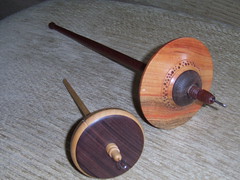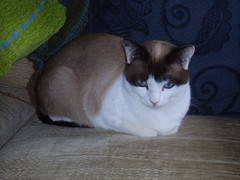I am a spindler. Back in 1994, I went to SOAR for the first time, and found that the clunky, infuriating things that I had been struggling to use could be turned upside down and become flights of fancy at the same time as things of utility. The tradition in my part of Europe was for bottom whorl spindles, and I did not at that stage know that any others existed. To talk about that aspect of spindling adequately, I would need to refresh my memory from a couple of books, but I did soon learn that top whorl spindles were widespread in the world and had indeed occurred in Britain and Northern Europe, if not as frequently as bottom whorl.
There is much talk of the physics of spindle spinning, too. I try, I really do, but to me, spindling is a tactile and dare I say it, intuitive thing, not a cerebral. There is a good article here, for those who are interested; and there is a quote from Michael Williams about his square top whorl spindles that goes a long way to explaining my point of view, maths-phobic that I am. (So, tell me, how come I ended up marrying a maths graduate?)
“The four corners have weight which is further from the axis and will produce a longer duration of spin. A square spindle with sides of a given dimension can spin up to 33% longer than a circular whorl of the same diameter and weight. (I used applied mathematics to calculate the improvement).”
Mind you, the performance of Michael's spindles is right up there with the best of the best, so he must be right - I just can't relate to it at all in those terms!

This is one that I am using at the moment. It is very small, weighing around 20gm. By a minor miracle, I still have the original label, so know that it comes from here. (And, having actually tracked them down for this post, I have contacted them...who could resist?)

The one on the right in this photograph is at the opposite end of the spectrum - big and heavy (over 50 gm, huge for me.) I fell in love with it, the feel of it in my hand and the way it spins, perfect for plying. The other is one from IST, another British maker, and also excellent.
One more before I start attempting to draw my thought into a rather more coherent form:

From left to right, a Bosworth moosie, a Spindlewood and a small, non rim weighted Golding. These represent three more makers that I enjoy and respect - there are others!
First of all, I greatly admire those that can dissect spindling into scientific and mathematical elements, and I have to accept that I cannot. Well, only up to a very limited extent, and then in subjective terms. So, what do I do?
Well, I invariably look for top whorl spindles. I taught myself to spin on dreadful bottom whorl ones, that were heavy and unbalanced. It was always necessary to twirl them at frequent intervals, and frankly, it was a miracle that I ever took to spindling at all. It is, though, only fair to say that spindle makers today give as much attention to making them as they do to top whorl - I simply have my, to me, very good reasons for not using them.
I do actually possess three - one by Greensleeves, one by Nick Brown of York Guild, who no longer makes spindles, and one by Rod Stevens of Woodchuck, sadly ditto. They are all super things, but I don't use them.
My personal preference - and note the form of words! - is for top whorl spindles. Why? Because I believe that on balance, they perform better - that you will get a longer, better balanced spin compared with a bottom whorl of similar quality. They are more efficient to use - a quick flick on the knee should produce more than enough spin for an arm's length of yarn. Winding on and rehooking is a quicker and smoother action than that with a bottom whorl, particularly if that has a notch rather than a hook (also another route to an oscillating spin.) And yes, I am ignoring the British fashion for winding the yarn under the whorl, here.
So, how do I choose a spindle?
I see a spindle - eye appeal alone will make me pick it up. But even at that point, something about the weight and/or balance of it will make me put it down immediately. If not, I will try it out with a little bit of fibre - funny how I always seem to have something about my person.
I can't pin down what I mean - but that spindle has to also "feel" right in use. Yes, I want it to spin for a long time, time enough to allow my hands to form as much yarn as my arms can accommodate. And yes, I do know that there are ways to extend that "arm's length" and I do sometimes employ them. But in the main, people are spinning in surroundings that are restricted in one way or another, so a simple arm's length is all I ask. The spin should be as wobble-free as possible - wobbling, or oscillation, seems to waste energy and will shorten the spin time as well as "feeling" odd. Sometimes with a top whorl spindle, you can gently touch it against your leg and the oscillation will stop - that is if the wobble is due to operator error and not an inherent fault in the spindle.
The spin itself has to feel right. Now, this will vary depending on the weight of the spindle and the fibre you intend to spin on it. Silk and cotton require a very fast spin, but if you want to make a more woolly yarn (relative term - if I want a really "woollen" yarn, I would rather spin on a wheel) then a long but slower spin would be what I looked for. The size and weight of the spindle does not necessarily determine this. I imagine this is where the physics might come in - density of wood, dimensions of whorl and shaft - but I will gauge it on the fly. The whorl and the shaft have to look right together. Although you can get caught out! Last year, I was given a spindle to try that had a small, thick whorl and a short, relatively thick shaft. I expected it to be dreadful, and it wasn't - on further inspection, I found that the whorl had brass weights sunk in to it, and this will have made the difference. Still not my favourite spindle, but nice - definitely more than adequate!
An intriguing thing that I notice over and over as I teach or sell spindles is that the tingle factor will draw an individual spinner to an individual spindle. sometimes, a succession of people will try one particular spindle; most of them will reject it; someone will exclaim and fall in love. this, I suppose, is where the science fails. There is always the variable of the individual. The length and strength of someone's fingers can't be pre-determined, nor can the effect of their fondness for cocobolo or purpleheart, the scientific and the subjective.
I think I may have rabitted on for long enough for now. Not to say that I won't revisit....Lets give you a gratuitous Ruby photograph, who enjoyed helping me photograph the spindles.

And let us reflect on just how good it is that we have these lovely little things to play with, no matter what the orientation!

3 comments:
I have played with the odd bottom whorl and find with my already shaky hands I manage invariably to end up with a shaky spindle and you are right, the oscillating does detract from the spin. (I may not ahve got the degree but I did do engineering ;)
Might I ask what that spindle was you lent me to try with? I dearly wish to buy my own for plying, it was a *dream* to use
My word for this comment is "Imbiast" well, yes I am :p
Thank you for this post. I am already a wheel spinner, but have just requested just his type of imformation from an on line group I am part of as I am getting ready to buy my first drop spindle. All previous drop spindles have been hand made. ;)
Thanks again!
For me the big problem... well, ONE of the big problems... with trying to science-up the discussion of spindles and how they work is that it's a dynamic system: it's going to change as you spin, and it's going to be impacted by so many individual factors, including human factors. Looking at the tool as a static object is all but meaningless, I find, because the relationship one must develop with one's own spindle is so personal that all the math and science ultimately can't help a person decide. It's like choosing a pen, except with even more variables in the mix.
I'm thrilled to see people interested in spindles... but man, it sure is hard to try to quantify and generalize, when the bottom lines comes down to "You gotta try a lot of them, and see what you like, because it's about how it feels for you." I love this post.
Post a Comment